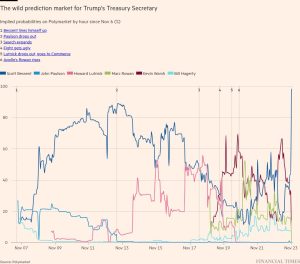Almost two-thirds of EU water in bad condition, report shows

Unlock the Editor’s Digest for free
Roula Khalaf, Editor of the FT, selects her favourite stories in this weekly newsletter.
Water scarcity affects a fifth of EU land and almost a third of its population each year, according to the biggest survey yet of the state of its water, and as much as two-thirds of its water bodies are in bad condition.
The rising stress on supply puts industries such as textiles and agriculture at risk and increases the deadly impacts of extreme weather, the European Environment Agency said in a major report released on Tuesday.
Europe is the world’s fastest-warming continent, partly because of its proximity to the Arctic where the ice melt exposes dark, heat-absorbing, ground and amplifies warming. It has experienced more extreme weather events as a result, including more frequent and deadly floods as well as droughts.
The EEA also drew attention to excessive pollution in the bloc’s waters, also mainly caused by industry and agriculture.
Almost two-thirds of Europe’s surface water, such as lakes and rivers, were not in a good ecological state, the agency said, with countries including Sweden, Germany and Poland among the worst affected.
A major cause of the high levels of water pollution came from mercury produced by coal-fired energy production, brominated fire retardants and agricultural pesticides getting into water supplies.
EU environment ministers from 21 countries out of the 27-strong bloc wrote to the European Commission in July, at the height of the summer water supply stress, urging “concrete action” to boost water security and resilience. This followed increased tensions over water access, in particular in southern European countries such as Italy, Greece and Spain.
In some Spanish regions, residents faced restrictions in order to maintain supplies for tourists and farmers. As the emergency worsened through July and August in the Mediterranean, parts of Spain and the Greek and Italian islands also imposed strict daily water rationing.
“We are already observing more extreme droughts and we are expecting this to get worse in the future,” said Trine Christiansen, head of the EEA’s freshwater and environment group. “This is not a situation that Europe’s water policy has prepared us well for.”
European Commission president Ursula von der Leyen announced a “water resilience initiative” in September last year, but it was subsequently shelved amid ongoing protests from farmers over the potential administrative burden.
Von der Leyen has since promised a European Water Resilience Strategy in guidelines for the next commission mandate, which should begin later this year, “to ensure sources are properly managed, scarcity is addressed”.
The commission has opened more than 500 proceedings against member states for contravention of water rules since 1999.
The EEA report showed that agriculture was by far the biggest consumer of water in the EU, using 59 per cent of supply compared with 13 per cent for households and services.
Cooling of power plants accounted for the majority of water abstraction, the EEA said, but did not consume as much as agriculture because most of the water used in electricity generation is returned to the environment.
Water stress occurs when water abstraction exceeds the level of available water. According to the Water Exploitation Index, Malta and Cyprus are the most water-stressed countries in the EU.
The EEA added that in some areas of southern Europe “despite already high water use” water consumption for irrigation had continued to creep up, increasing 8 per cent since 2010.
“There is a serious need to change agricultural practices . . . to reduce pollution and adapt agriculture to lower water use,” Christiansen said.
Increasing water stress is also likely to result in ballooning costs to deal with fires, droughts and floods. The EU-wide droughts and fires in 2022 resulted in €40bn worth of damage, according to the EEA, while the European Commission’s Joint Research Centre has suggested that direct damage from flooding is likely to increase six-fold by 2100.
A separate report published by the industry body Water Europe on Monday said that €255bn of investment was needed in Europe’s water infrastructure over the next six years if EU countries were to comply with EU standards on water cleanliness and supply.
Climate Capital

Where climate change meets business, markets and politics. Explore the FT’s coverage here.
Are you curious about the FT’s environmental sustainability commitments? Find out more about our science-based targets here
#twothirds #water #bad #condition #report #shows








